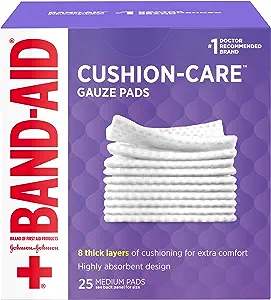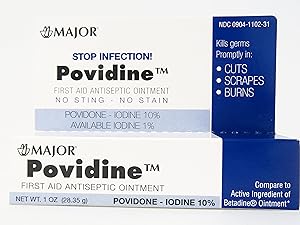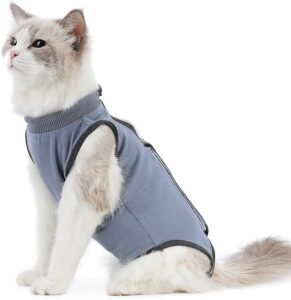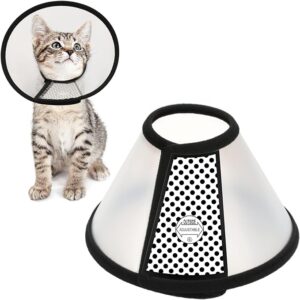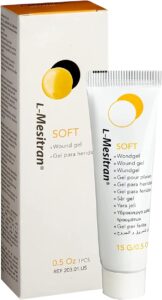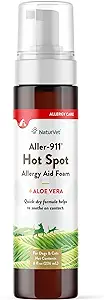Different types of chest wounds in a cat
Unfortunately, not every cat has the same wound on its chest. And the deeper the wound is, the more intens you need to treat your cat’s wound. That is why we will first explain things about a wound on your cat’s chest.
If you have noticed that your cat has a wound that is larger than a coin and it is not a superficial abrasion, it is best to take him to your vet. Also do this if the wound is wide open and the skin edges do not touch each other. This vet will examine your cat and if it is a fresh wound, the wound may be stitched up. The chance of complications during recovery is in that case considerably reduced.
If the wound on your cat’s chest is significantly smaller than a coin, you can treat it at home. But your cat does need to otherwise behave normally. He may feel some pain, but his breathing should be normal and he should be eating and drinking well. He also should not be limping. If there is something that is not normal for your cat, it is better to contact your own vet and have him or her examine the wound.
A scrape wound (abrasion) on your cat's chest
If your cat only has a scrape wound on its chest, the wound may be slightly larger than a coin. In any case, the skin must not be cut through to the layer of muscles or other subcutaneous tissue. The skin on the chest is usually about 2-3mm thick so if the wound goes deeper than that, the skin layer is completely torn or punctured. With an abrasion you cannot move the two sides of the wound differently in relation to each other. If you move one side of the abrasion, the other side will move in a normal way. With a deep wound you will see that the side on the other side of the wound does not move or moves moderately when you move one side.
A deep open wound on your cat's chest
As mentioned, there is also the possibility of a deep wound where the skin is completely torn or cut. The wound then extends to, or sometimes even into, the underlying tissues. Near the ribs you usually see muscle tissue, sometimes some subcutaneous fat. Muscle tissue looks like the meat you buy in the store and fat tissue is a white blubbery mass. Very occasionally you can also see a tendon plate, which looks like a mother-of-pearl-like white flat membrane.
Of course, a lot of blood can make the wound on your cat’s chest a bit difficult to examine. What is important now is whether the skin is completely through or not. Is it bleeding a lot? Then use some gauze compresses to blot away the blood and examine the wound. If you don’t have gauze at home you may use a clean, washed cloth without any dirt on it.
What to do if your cat has a wound?
If your cat has a deep open wound that is larger than a coin, it is wise to take him to your vet. A superficial abrasion on your cat’s chest may be larger, but the skin must still be whole. Below we explain the different steps you need to take to care for your cat’s chest wound at home.
Maintain calm before approaching your injured cat
It is of course quite a shock if your cat suddenly comes home with a bleeding wound on its chest. But your cat will also be frightened by it and if you fly towards him like a panicked bird, he will be even more frightened. There is a very good chance that he will no longer want to cooperate. So first relax yourself. It is only necessary to take immediate action when an extremely large amount of blood flows out. If it drips out, you really have a minute to calm yourself down. This bleeding also removes most of the dirt, so just let it go for a while.
Have you recovered from the shock a bit? Nice. Then you can now calmly approach your cat. It is best if you can do this with two people. One will hold your cat and the other will deal with the wound. Do not keep your cat in a tight grip, as this will only make it more likely that he wants to try to break free and therefore work against the treatment. Just make sure he stays on the surface and is a little distracted. He is allowed to move a bit during his treatment.
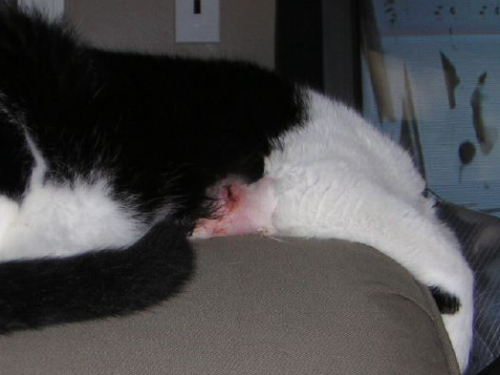
Cleaning the wound
Now you can start working on the wound. It is important that the wound no longer contains any pieces of dirt. We mean visible dirt. So no sand, small peaces of rocks or even pieces of another cat’s teeth. The wound should look clean. You can clean it by moistening a gauze compress with clean tap water. If you are in a country where the quality of the water is not optimal, you can use boiled, cooled down water or still water from a bottle.
Carefully clean the wound with this wet compress. Hairs should be cut short if they can stick to the wound. Just gently cut away the surrounding two centimeters of hair. This is also done in the photo above. It won’t be pretty, but it is better for the wound healing. Is the wound completely clean now? Then you will now disinfect the wound. We explain this part in the text below.
Disinfecting the wound
By cleaning you have removed the visible dirt from the wound. But there is also invisible dirt. This includes bacteria, viruses, fungi, etc. These can multiply in the wound and thus cause a wound infection. This makes the problem even worse!
You can disinfect the wound on your cat’s chest by, for example, applying iodine ointment to the wound. Iodine solution is also allowed, but because it is more watery than ointment, it is more difficult to use on your cat’s chest.
Protect the wound
Now that the wound has been cleaned and disinfected, you can let the wound dry to the air. Does your cat tend to lick or scratch the wound? Then it is best to put a medical pet shirt on him. A romper for small children is also possible, but this has a slightly less perfect fit for cats. Be sure to apply a gauze compress to the wound so that the medical pet shirt does not get too dirty. Keeping it completely clean is almost impossible, but try as much as possible.
Does your cat continue to bite or lick his wound despite the shirt? Then it would be better to put a protective collar on him. However, this does cause some stress for your cat. He hates it! And stress in turn causes poorer wound healing. So use a medical pet shirt rather than a collar if that works well enough for your cat.
Caring for a scrape wound on your cat's chest
After cleaning and disinfecting the wound on your cat’s chest, the wound will need to be cared for for a few days. This means that you look at the wound and assess whether healing is going well. And you apply a healing ointment to it.
Healing is successful when a dry crust forms on the wound that adheres firmly to the damaged skin underneath. Does it come off very easily? Then a wound infection has developed. But with an abrasion you usually see a wet layer over the wound in case of a wound infection. If you see a wet layer on your cat’s wound, it is necessary to clean the wound again. That dirty layer, that is full with bacteria, needs to be removed. Then you apply the iodine ointment again. Unfortunately, you will have to continue to do this twice a day for the next 5 days. This way, bacteria and viruses do not have a chance to develop further and the wound can heal.
Is wound healing going well? In other words, is there a firm, dry crust on the wound? In that case, it is wise to treat the wound twice a day with honey ointment or other wound healing ointment. You do this for 5-7 days. The wound healing ointment contains substances that stimulate cell division so that the wound closes and heals faster. It also contains substances that prevent the formation of bacteria. If everything goes well, the wound should be almost healed after a week.
Caring for a deep open wound on your cat's chest
Since a deep open wound on your cat’s chest is more likely to cause a wound infection, the aftercare is slightly different from the aftercare for an abrasion.
In the case of a deep open wound, continue to treat the wound with iodine ointment twice a day for 5 days. This ensures that bacteria in the depth of the wound have less opportunity to grow. The only disadvantage of iodine is that wound healing is slightly slower. However, a wound infection does not cause wound healing at all, so iodine is better in this case. Cats can also get diarrhea if they lick a lot of the iodine. So make sure that your cat wears a medical pet shirt during the time you treat him with iodine.
Even with a deep open wound, healing proceeds well if a crust forms that you can’t easily remove. If bacteria are formed deep down, the crust cannot adhere to the tissues and therefore comes off easily. So during the first two days, try to see if the crust that has formed comes off easily and if so, remove it and apply the iodine well. After a few days, the crust that has formed should remain firmly in place.
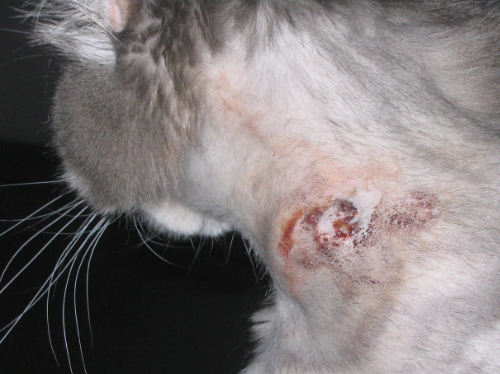
What does an infected wound on the chest look like in your cat?
An inflamed wound almost always contains an infection. This means that bacteria multiply in the wound and that your cat sends pus-cells to that area to clean up those bacteria. The result is an infected wound with a lot of pus in it. A hard crust usually does not form, but the wound remains wet and may contain a layer of pus. However, most cats will lick the wound clean themselves, unless you have put a medical pet shirt or protective collar on it.
But is your cat’s wound wet and does it smell a bit? Then unfortunately the wound has probably become infected.
Another thing is the formation of an abscess. In that case, a bacteria has gotten under your cat’s skin and has started to multiply. Your cat has tried to counteract this by sending pus cells there. An abscess then forms under the skin. This is a cavity under the skin filled with pus and bacteria. This can burst open after a few days and spread a huge stench and bloody and purulent fluid. Above you see a photo of a cat with a broken abscess. You need to treat this abscess the way we explain below.
Treating an infected wound on your cat's chest
An infected wound is best treated with a course of antibiotics. But then you have to go to your vet and pay for a consultation. You can also treat the infected wound on your cat’s chest with an iodine solution twice a day. In this case, the iodine solution is better than the iodine ointment (but more difficult) because it penetrates more easily into the depth of the wound into the smallest nooks and crannies.
Try to remove any loose crust as much as possible and clean the wound as much as possible before dripping the iodine on it. Use a gauze pad to do this. Every time you apply iodine, you must first freshen the wound as much as possible. After about 2-3 days you should see that the wound is clearly calming down and after 5 days the wound should look like a normal wound. In principle, 5 days of treatment should be sufficient. But if you think that things are improving, but it is not yet good enough, you can also extend it to 7 days. If it has not yet become a nice healing wound by then, it is better to take your cat to your vet. And of course, your cat should not act ill and must want to eat well during that period.
Treating a bite wound on your cat
It is best to clean a bite wound on your cat caused by another cat. This way you hopefully prevent the formation of an abscess. In this case you drop some iodine solution into the cavity of the wound to disinfect it. This way you prevent the formation of bacteria as much as possible. After all, they came with the tooth under your cat’s skin.
In the days that follow, you should keep a close eye on the bite site. If a painful swelling occurs, an abscess is probably forming and it is best to start a course of antibiotics from your vet as soon as possible. The sooner you tackle this, the less damage will occur to the skin. If the abscess has now burst open, you can first see whether treating with iodine solution twice a day is sufficient. But here too, your cat should not start acting ill.
Your cat's wound smells very bad
If a wound smells very bad, there is almost always a wound infection. An ordinary wound can also give a strange smell, but people almost never describe it as smelly. With a wound infection, a lot of bacteria have started to grow in the wound. These bacteria produce certain substances with a foul odor and release them into the air. This causes a very smelly odor to come from the wound.
In this case, it is best to take your cat to your vet. He or she can then prescribe a course of antibiotics for your cat. If you really don’t want to do that for whatever reason, you will have to rub or dab the wound with iodine (ointment or solution, it doesn’t matter much in this case) 3 times a day. In most cases, the odor will have diminished considerably after about 2-3 days because you kill the bacteria and also prevent new bacteria from forming. You should continue to do this for about 7 days. Longer is also allowed if you think that the wound does not yet look in an optimal condition. Has there still been no healing after 2 weeks? Then it is better to visit your vet.
Cat keeps scratching the wound
When a wound heals or becomes infected, a wound can also become itchy. In that case, your cat may scratch its wound open again and again as a result of this itching. This makes the wound much more difficult to heal. In that case, it is necessary to relieve him from his itching with an ointment such as Aller-911 Hot spot . This ointment reduces itching in infected wounds and also does not or hardly sting the wound.
In addition, it is necessary to protect the wound from your cat’s nails or teeth. Cut his nails as short as possible and put a medical pet shirt on him if he scratches the wound. But if he keeps biting the wound open, you will unfortunately have to opt for the protective collar. In most cases, the wound has healed after a week.
If the wound really does not heal by itself you can use a hydrocortisone cream on the wound. But this makes that woundhealing itself is going slower. It does however reduce the itch for your cat. Is your cat constantly destroying woundhealing due to the itch, only then you can use the hydrocortisone cream. But don’t use it if there is just a mild itch!
Can a cat hurt itself?
Yes, unfortunately that can happen. They do not do this consciously, but they may be so itchy or experience a nagging pain that they bite, lick or scratch themselves, causing a wound. And this wound can become infected and inflamed. But a deep open wound is very rarely caused by your cat itself. In that case, either there has been an accident or fight, or your cat has an abscess that has burst open and now looks like a wound.
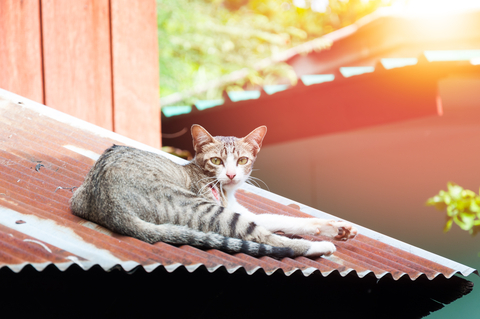
The wound on your cat's chest is not healing
There are actually three possible causes for this. First of all, your cat may keep scratching or biting the wound itself. But it is also possible that a wound infection has occurred so that the bacteria in the wound prevent healing. And it is also possible that constant skin inflammation occurs as a result of an allergic reaction. In this case, the inflammatory response arises, as it were, from within.
Good luck!
Hopefully you have found the answers you were looking for on this page so your cat can heal soon from the wound on his chest. Good luck for the both of you!

